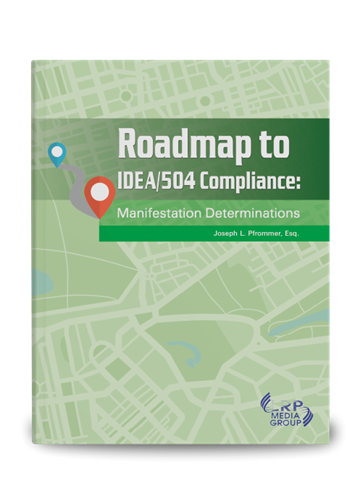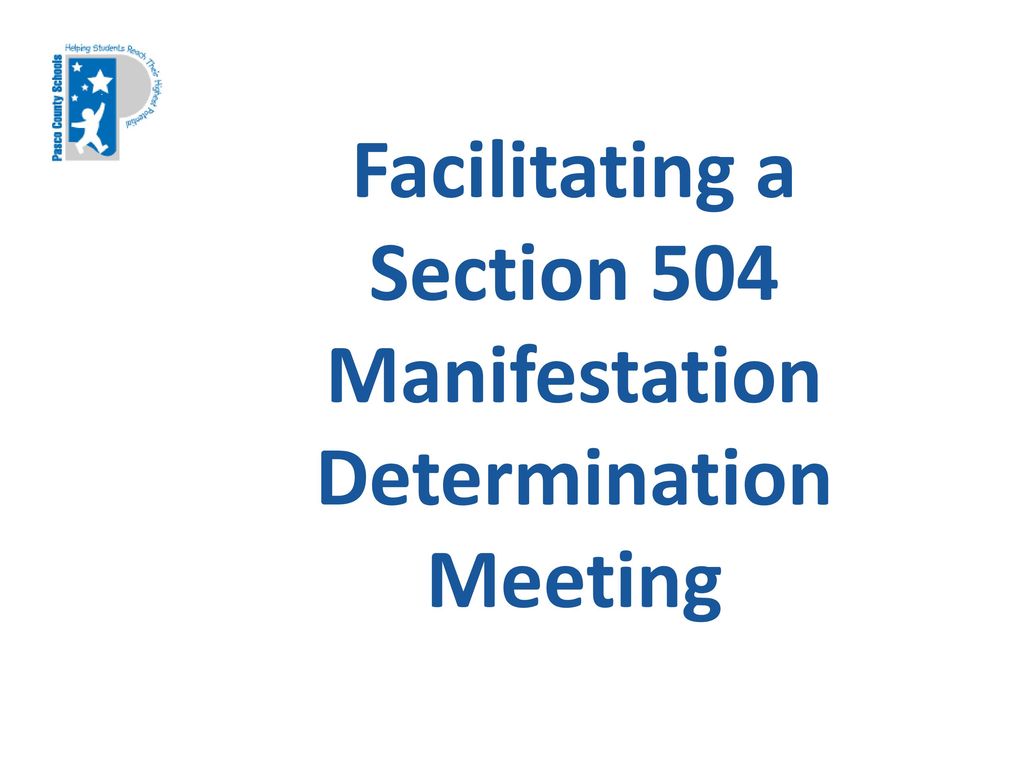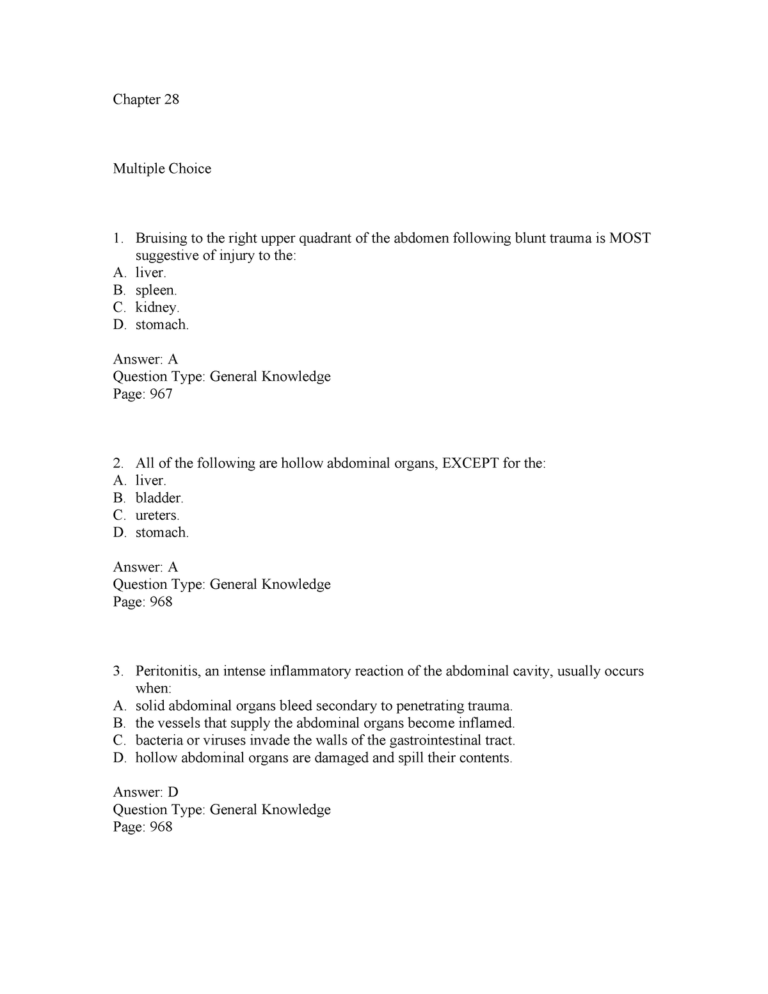504 Manifestation Determination
In the context of special education, a 504 Manifestation Determination is the process of assessing whether a student’s behavior is a result of their disability. This determination is made to ensure that the student’s rights and educational needs are met in a suitable manner.
Understanding the 504 Manifestation Determination is essential for educators, parents, and students alike. It ensures that students with disabilities are given fair treatment and support within the education system. By examining this process, we can gain valuable insights into how it supports the academic and emotional well-being of students with disabilities.
This article explores the intricacies of the 504 Manifestation Determination, shedding light on its significance and implications within the educational landscape.

Credit: slideplayer.com
What Is A 504 Plan?
A 504 Plan, also known as a Section 504 Plan, is a legal document that ensures students with disabilities have equal access to education. It is designed to provide support and accommodations to students who do not qualify for an Individualized Education Program (IEP) but still require assistance to succeed in school.
Eligibility And Purpose
In order to qualify for a 504 Plan, a student must have a disability that affects a major life activity. This can include physical impairments, learning disabilities, mental health disorders, or chronic health conditions. The purpose of a 504 Plan is to remove barriers and provide necessary accommodations to allow students to fully participate in their education.
Components Of A 504 Plan
A 504 Plan is individualized and tailored to meet the specific needs of each student. It typically includes the following components:
- Identification of the disability: The student’s disability is clearly documented and recognized.
- Description of how the disability impacts the student: This section outlines the specific challenges the student faces in relation to their disability.
- Accommodations and services: A list of accommodations and support services is included to address the student’s needs. These can range from adjustments in the classroom environment to additional testing accommodations.
- Person responsible for implementation: The individual or team responsible for implementing the 504 Plan is identified. This may include teachers, administrators, and other school staff.
- Progress monitoring and evaluation: The plan includes a method for monitoring the student’s progress and evaluating the effectiveness of the accommodations and services provided.
A 504 Plan is a valuable tool that ensures students with disabilities receive the necessary support and accommodations to succeed in school. By addressing their specific needs, it promotes a more inclusive and equal educational experience for all students.
When Is A Manifestation Determination Necessary?
In special education, a Manifestation Determination is necessary when evaluating a student’s behavior in relation to their disability.
Triggers For Manifestation Determination
Evaluating incidents of behavior, frequency of behavior, and impact on learning.
Importance Of The Process
Ensures student rights are upheld, stakeholders are involved, and interventions are tailored.
Process Of Conducting A Manifestation Determination
During a 504 Manifestation Determination, the process involves a thorough assessment of whether a student’s disability is the cause of their behavior that led to disciplinary action. This includes a review of the student’s behavior, the disability, and whether the school had awareness of the disability before the behavior occurred.
The school must conduct the determination within 10 days of the decision to change the student’s placement.
Gathering Relevant Information
Before conducting a Manifestation Determination for a 504 plan, collect all relevant information.
- Review student’s academic and behavior history.
- Gather input from teachers, parents, and any relevant stakeholders.
- Consider any evaluations or assessments conducted on the student.
Convening The Manifestation Determination Review (mdr) Meeting
Schedule and conduct the MDR meeting to determine if behavior is a result of the student’s disability.
- Invite essential team members including parents, teachers, and school administrators.
- Present gathered information and discuss the student’s behavior and disability status.
- Determine if the behavior is a manifestation of the student’s disability.
Factors Considered During The Determination
When it comes to conducting a 504 manifestation determination, several factors must be taken into consideration. These factors help educational teams assess whether a student’s behavior is directly related to their disability and whether appropriate accommodations and supports have been provided. Let’s take a closer look at the key factors that play a crucial role in the determination process.
Behavioral Observations
Behavioral observations are a vital component of the 504 manifestation determination. School personnel closely monitor the student’s behavior in various settings, such as the classroom, the playground, or during extracurricular activities. These observations aim to identify patterns and triggers that may contribute to the student’s behavioral challenges. By closely examining the student’s behaviors, educational teams can better understand whether the behaviors are a result of their disability or other factors.
Documentation And Testimony
The review of relevant documentation and testimony is another crucial aspect of the 504 manifestation determination. This can include the student’s Individualized Education Program (IEP), medical records, progress reports, behavior logs, and any other relevant documents. Additionally, testimony from teachers, parents, and other individuals who have regular contact with the student can provide valuable insights into the student’s behavior, challenges, and any previous attempts made to address them. This documentation and testimony serve as evidence and help educational teams make an informed determination.
Outcomes Of A Manifestation Determination
The outcomes of a Manifestation Determination are crucial in determining the impact on a student’s 504 Plan. It is essential to understand the possible determinations and the subsequent effects on the student’s learning experience.
Possible Determinations
During a Manifestation Determination review, there are three possible determinations:
- Behavioral Incident is a Manifestation of the Student’s Disability
- Behavioral Incident is Not a Manifestation of the Student’s Disability
- No Educational Plan or IEP in Place
Impact On The Student’s 504 Plan
If the behavioral incident is determined to be a manifestation of the student’s disability, the 504 Plan may be revised or adjusted to address the student’s needs and prevent similar incidents in the future. If the incident is found not to be related to the student’s disability, the school may address the issue through disciplinary actions without making adjustments to the 504 Plan. If there is no educational plan or IEP in place, the school must follow discipline procedures for all students.
Parental Involvement And Rights
As a parent, your involvement and rights play a crucial role in the 504 Manifestation Determination process. It is important for you to be informed and actively participate in order to ensure the best outcomes for your child. This section will highlight the key aspects of parental involvement and rights, including notification and participation, as well as the appeal process to address any concerns you may have.
Notification And Participation
When it comes to the 504 Manifestation Determination, notification and participation are essential components for parents. Schools must notify parents of any meetings or decisions regarding their child’s educational plan. This notification should include the purpose of the meeting, the date and time, as well as the right to participate and make their voice heard.
Parents have the right to request to be part of the decision-making process and have their input considered. This can be done through attending meetings, expressing concerns, providing relevant information about their child, and actively engaging in discussions about the educational plan.
It is important for parents to be proactive in ensuring their participation by communicating with the school, asking questions, and seeking clarification if needed. By actively participating, parents can help shape the educational plan to better suit their child’s individual needs and ensure their rights are upheld.
Appeal Process
If parents have concerns or disagreements with regards to the 504 Manifestation Determination, they have the right to appeal the decision. The appeal process provides an opportunity for parents to seek resolution and ensure their child’s educational needs are appropriately addressed.
Parents can initiate the appeal process by filing a complaint with the school or school district’s designated authority, typically the Section 504 Coordinator. They should provide any supporting documentation or evidence to substantiate their concerns. The school or district will then conduct an investigation and review the appeal in a fair and unbiased manner.
During the appeal process, parents have the right to present their case, provide additional information, and request support from an advocate or legal counsel. It is important to follow any specific procedures or timelines set by the school or district to ensure a smooth and timely resolution.
After reviewing the appeal, the school or district will render a decision. If parents are not satisfied with the outcome, they may further escalate the matter to the appropriate state or federal authority for further review and resolution.
Remember, as a parent, you have the right to be involved, informed, and to advocate for your child throughout the 504 Manifestation Determination process. By understanding and exercising your rights, you can ensure that your child’s educational needs are met and that they have the best chance for success.
Key Differences Between Manifestation Determination And Disciplinary Procedures
Key Differences Between Manifestation Determination and Disciplinary Procedures
504 Manifestation Determination focuses on identifying link between disability and behavior.
Disciplinary procedures aim to address student’s behavior and administer consequences.
504 team determines if there’s a causal relationship with disability.
Disciplinary procedures involve school administrators and staff.
Judgment is based on evidence and documentation rather than suspensions.
School administrators have authority in disciplinary procedures.
Team collaboration and student safety are paramount in manifestation determination.
Decisions consider both educational and legal aspects.
Contributions from parents, teachers, and relevant professionals play key roles.

Credit: www.shoplrp.com
Ensuring Compliance And Follow-up Actions
When it comes to ensuring compliance and follow-up actions, implementation of supportive measures is crucial.
Implementing Supportive Measures
Educational stakeholders must collaborate to provide necessary support for 504 Manifestation Determination. Supportive measures enhance student success and well-being.
Monitoring And Periodic Reviews
Consistent monitoring and periodic reviews are key components to ensure compliance with the 504 Manifestation Determination. Regular evaluation keeps the process effective.

Credit: www.uslegalforms.com
Conclusion
The 504 manifestation determination process is a crucial step to ensure that students with disabilities receive the necessary support and accommodations they need to succeed academically. By formally assessing the relationship between a student’s behavior and their disability, educators can make informed decisions to create a supportive learning environment.
Understanding the purpose and steps involved in this process allows educators to better advocate for their students and ensure that their individual needs are met. Get started today and empower students with disabilities to thrive in their educational journey.






